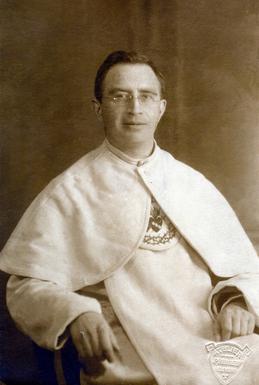Eustáquio van Lieshout facts for kids
Quick facts for kids BlessedEustáquio van Lieshout SS.CC. |
|
|---|---|
 |
|
| Born | November 3, 1890 Aarle-Rixtel, North Brabant, Netherlands |
| Died | August 30, 1943 (aged 52) Belo Horizonte, Minas Gerais, Brazil |
| Venerated in | Roman Catholic Church |
| Beatified | June 15, 2006, Belo Horizonte, Brazil by Cardinal José Saraiva Martins, C.M.F., for Pope Benedict XVI |
Eustáquio van Lieshout (born November 3, 1890 – died August 30, 1943) was a Dutch missionary and a priest in Brazil. He was part of a religious group called the Congregation of the Sacred Hearts of Jesus and Mary. He is known for his work helping people and for his strong faith.
Contents
Early Life and Calling
Eustáquio was born Huub van Lieshout on November 3, 1890. He grew up in a small town called Aarle-Rixtel in the Netherlands. He was the eighth of eleven children in a very religious family.
In 1903, he started attending a Latin school. He later read a book about another missionary, Damien de Veuster. This inspired him to join a religious group called the Picpus Fathers in 1913. When he joined, he chose the religious name Eustachius.
After finishing his studies, he became a priest in August 1919. His first jobs included helping new members of his order. He also worked in towns in the Netherlands, helping many people who had to leave their homes during difficult times. The King of Belgium even honored him for his good work.
Missionary Work in Brazil
In 1924, Eustáquio was preparing to go to Uruguay. But instead, he was sent to Brazil, where people spoke Portuguese. He arrived in Brazil on May 12, 1925, with two other priests and three brothers from his order. They went to help a local bishop who needed assistance.
On July 15, he became the pastor (a church leader) in a town called Agua Suja. Many people in this area were looking for gold. Father Eustáquio worked hard to help them live according to their Catholic faith. Over time, he helped the community become more virtuous and faithful.
Challenges and Crowds
In 1935, Father Eustáquio was moved to another town called Poá. When people heard he was leaving Agua Suja, they tried to stop him. But he followed his superiors' orders and moved to Poá.
In Poá, he worked to help people who were involved in other religious practices. He became very well-known for his blessings and for helping sick people get better through prayer. Many people believed these were miracles. Because of this, Poá became a popular place for people to visit and seek his help.
However, this popularity also caused problems. So many people came that there wasn't enough transportation or housing. The town became very crowded, and it was hard to keep things clean and orderly. There were also some people who tried to take advantage of the crowds.
Because of these issues, Father Eustáquio was asked to leave Poá. Even after he left, huge crowds continued to follow him wherever he went. The authorities in Brazil became worried about the large gatherings. They didn't have anything against him personally, but they were concerned about the commotion.
A high-ranking church leader in Rio de Janeiro asked Father Eustáquio to leave the capital city. He left Poá in May 1941.
Final Years and Legacy
Father Eustáquio found a quiet place to stay for about a year. His last assignment was as a pastor in Belo Horizonte. He spent the last two years of his life there. He had an assistant who helped manage the crowds, so he could focus on his parish work.
He became sick after an insect bite and passed away on August 30, 1943. He spent his last years near Jardim Montanhês, serving masses in the Cristo Rei chapel. He often traveled around the area, sharing his message of "health and peace" through faith and kindness.
After his death, people found a small, pointed metal chain on his body, which he had used for prayer. Many people believe that miracles have happened through his prayers. He was first buried in one church in Belo Horizonte, but later moved to the Church of the Sacred Hearts of Jesus and Mary in 1949.
Becoming Blessed
On April 12, 2003, Pope John Paul II recognized Father Eustáquio van Lieshout's heroic virtues, meaning he lived a life of great goodness.
Later, on December 19, 2005, a miracle was officially recognized as happening because of his prayers. Because of this, Father Eustáquio was declared "Blessed" on June 15, 2006. This special ceremony took place in Belo Horizonte, Brazil, on the day of Corpus Christi. A Cardinal named José Saraiva Martins led the service on behalf of Pope Benedict XVI.

